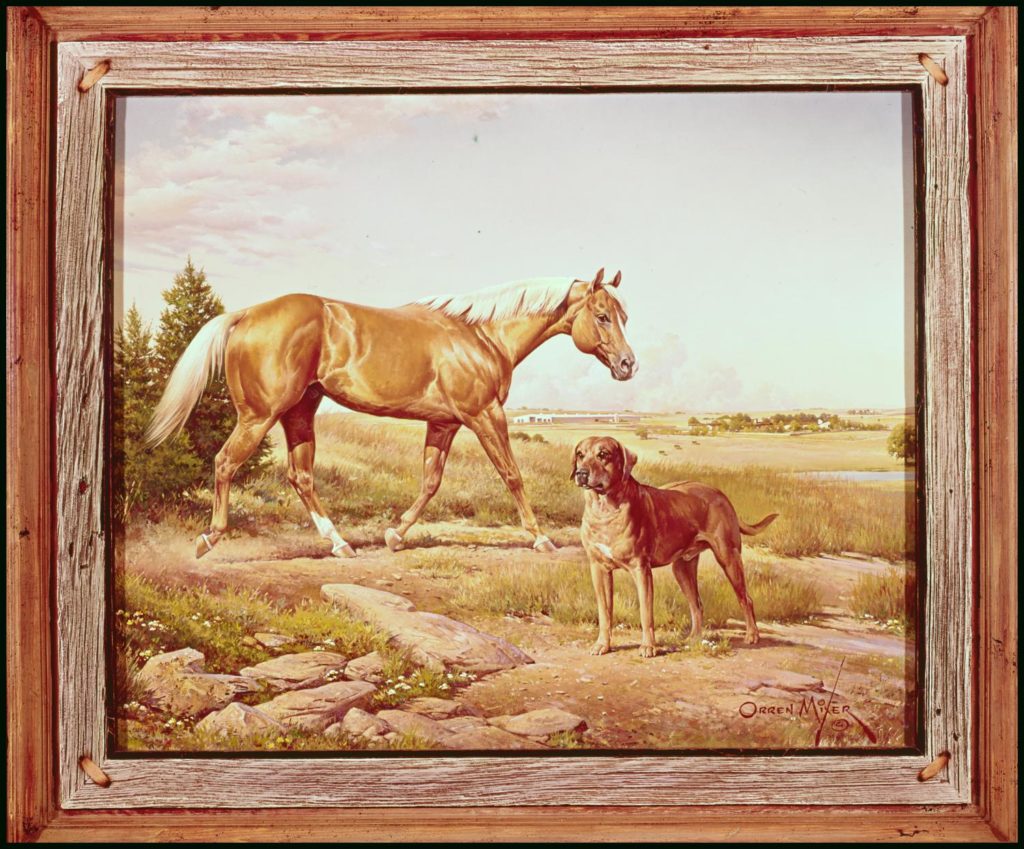Horsing Around with Ridgebacks
Many years ago, at a dog show in Virginia, I treated myself to a gold pendant of a gaiting Ridgeback. I am fussy about the depictions of the breed that I buy — none of those wrinkled, Mastiff wanna-bes with ridges for me. And this gold-cast Ridgeback was as good as they get, in my opinion.
Recently, I took the piece in to a jeweler and asked him to make up a new bail.”Nice horse,” he said appreciatively.

I corrected him, and noted that he wasn’t the first to make that mistake. And it’s understandable: A good Ridgeback should remind of you of a thoroughbred horse — hard muscled but stylish, effortless but powerful in motion.
That analogy was driven home at the 2016 Rhodesian Ridgeback World Congress this June in Lund, Sweden, where British breeder-judge Ann Woodrow did an in-depth presentation comparing the Ridgeback to its equine counterparts. The dog world has its equivalent of quarter horses, she explained. (Think of a stocky galloper like the Bullmastiff.) On the other end of the spectrum are the Arabians, built for sheer speed and beauty, refinement personified. And somewhere in the middle, Ann reminded, is the thoroughbred — and, for that matter, the Ridgeback.
It’s no coincidence, of course, that the modern Ridgeback standard “borrowed” liberally from the Dalmatian standard of the 1940s. Both breeds are endurance trotters, expected to follow a rider on horseback for hours without breaking down or tiring.

For quite a while now, I’ve been seeing a print of a horse and a Ridgeback popping up on eBay. Painted by Orren Mixer, it features a famous horse, and his not-so-famous Ridgeback companion. The horse, Cutter Bill, born in 1952, was a quarter-horse stallion; as his name suggests, he was a star at the equestrian sport of cutting, a western-style competition in which horse and rider work as a team to demonstrate their athleticism and ability to work cattle. Lep the Ridgeback was Cutter Bill’s stablemate, and their barn in Denton, Texas, is visible in the background of the painting.

Photo courtesy Horse Country USA Archive
Now, to be honest, Lep is not my style Ridgeback: Like many dogs of his era, he was heavier and more roughly made than the dogs we favor today. In this, he follows Ann’s Ridgeback-to-horse comparison quite neatly, looking more like his quarter-horse companion than the more elegant thoroughbreds on which the ideal template of the breed is based.
Both Cutter Bill and Lep were owned by Rex Cauble, a larger-than-life Texan who was convicted in 1982 on racketeering charges for his involvement with the so-called “Cowboy Mafia” marijuana smugglers. Cauble, who died in 2003, maintaining his innocence all the while, could have a hair-trigger temper: An article in Dallas-based D magazine says that when a ranch employee stumbled over Lep, Rex pistol-whipped him for his carelessness.
The millionaire rancher had another at least one other Ridgeback, but Lep appears to have been his favorite.

Catahoula Leopard Dog.
Cauble then bred one of them to a “Leopard Cowdog” — presumably, a Catahoula Leopard Dog, which is a hog-hunting cur named after the Louisiana parish where it was developed. As the photo to the left suggests, but for the merle coat, that breed does evoke the Ridgeback more than most others. Which is probably why Lep, who was named for his Catahoula parent and weighed in at 155 pounds, looked like a purebred Ridgeback — except, perhaps, for his size.
“When he lies on the back seat of Cauble’s Cadillac, he covers it, brother, he covers it!” the story gushed.
And that’s quite enough horsing around for today.
The Ridgeback’s 12 Days of Christmas
In December 1997, the last time she permitted herself the luxury of Yuletide décor, Ridgeback lover and rescuer Elise Lewis of Chattanooga, Tennessee, penned a parody of breed-specific holiday mayhem. After posting “The Ridgeback’s 12 Days of Christmas” on a popular email list, and singing it at her office Christmas party, she promptly forgot about it.
But, like the literary version of a designer dog, it soon surfaced in unlikely mutations. “I’ve seen it changed to Shepherd, Xolo, Great Dane, Golden Doodle – any two-syllable dog breed will do,” Elise says.
A less amusing change was Elise’s name morphing into “Author Unknown.”
Here are the lyrics:
On the eleventh day of Christmas, my Ridgeback gave to me:
Eleven unwrapped presents
Ten Christmas cards I shoulda mailed
My wreath in nine pieces
Eight tiny reindeer fragments
Seven scraps of wrapping paper
Six yards of soggy ribbon
Five chewed-up stockings
Four broken window candles
Three punctured ornaments
Two leaking bubbles lights
And the Santa topper from the Christmas tree.
On the twelfth day of Christmas, my Ridgeback gave to me:
A dozen puppy kisses
And I forgot all about the other eleven days.
Excerpted from 100 Memorable Rhodesian Ridgeback Moments